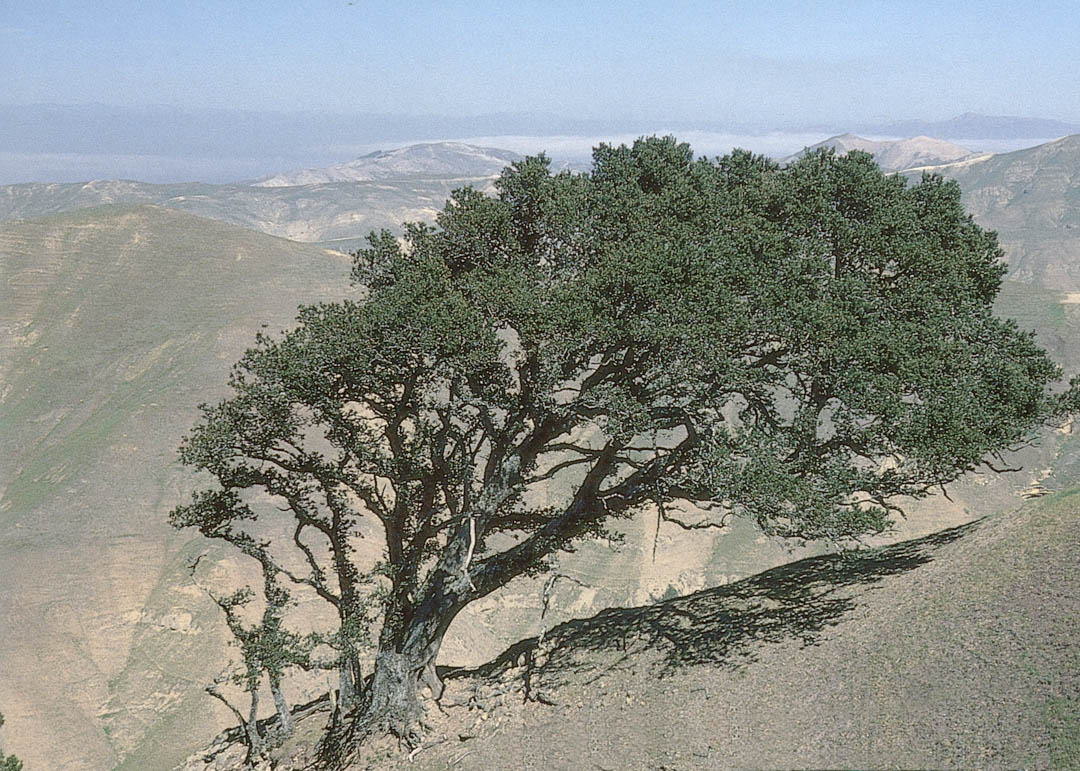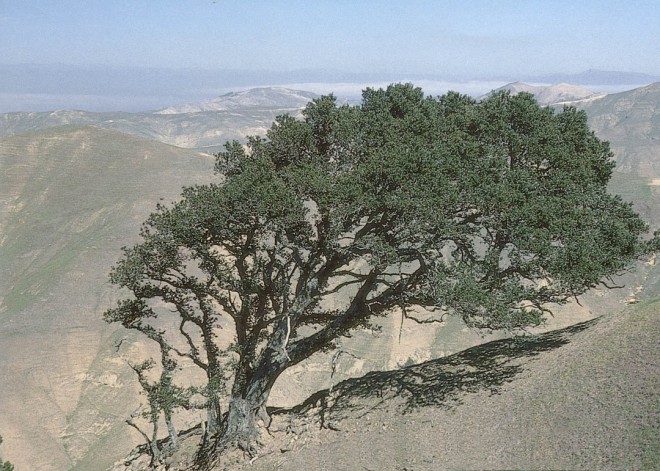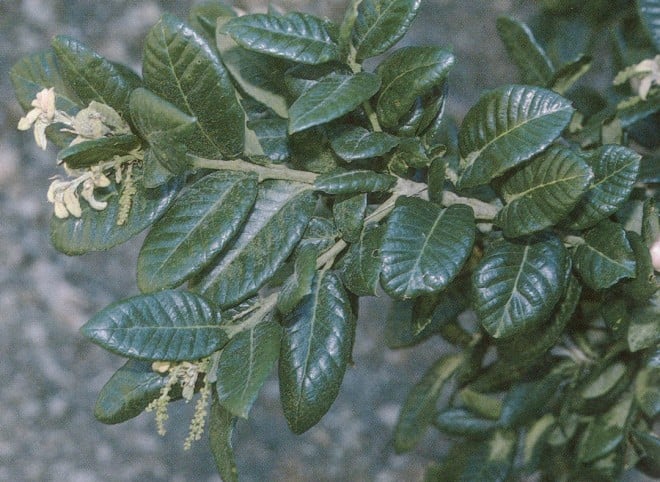

Contributor
- Topics: Archive, Growing for Biodiversity, Plants You Need

Toss the word “rare” into the description of a plant and gardeners perk up. In the case of island oak (Quercus tomentella), the term is doubly appropriate. Not only is it the rarest oak in the California flora, but it is also scarce in nurseries, a situation that many admirers would like to change.
According to The Jepson Manual, there are eighteen species of oaks native to California, many distinct variants, and several naturally occurring named hybrids. Coast live, valley, Engelmann, and black oaks are perhaps the most widely known and grown of the tree species, but “some consider [the island oak] the handsomest of California’s evergreen oaks.” (Sunset Western Garden Book)
The fossil record indicates that island oak was once present on the California mainland during the more moist Miocene and Pliocene periods. As new mountains formed and the climate became progressively drier, its range gradually dwindled. The species is now a relictual endemic on Anacapa, Santa Cruz, Santa Rosa, Santa Catalina, San Clemente, and Guadalupe islands. Island oak is typically found on steep north-facing slopes and canyons in association with such island endemics as Catalina ironwood (Lyonothamnus floribundus), feltleaf ceanothus (Ceanothus arboreus), and Catalina cherry (Prunus lyonii) in the island woodland plant community and in the drier, rockier, island chaparral. Isolated populations also occur on exposed ridge-tops and peaks. In some locations, trees exposed to relentless, salt-laden ocean winds exhibit contorted shapes—nature’s form of bonsai. The presence of summer fog is a common feature in all of these environments.

Thanks to the often controversial efforts of the National Park Service, The Nature Conservancy, the Catalina Island Conservancy, and the US Navy, the once serious grazing and trampling threats posed by cattle and feral animals are now reduced on all but Guadalupe Island (the type locality for the species). Pigs are still problematic on Santa Cruz, as are deer and elk on Santa Rosa. To boost regeneration of island oaks on Santa Rosa, acorns were gathered and propagated at the Santa Barbara Botanic Garden for re-introduction. Planted in a harsh, heavily eroded site, a third of these individuals are alive today, despite minimal aftercare.
A walk through our garden illustrates how variable island oak can be. Some of this variability can be attributed to hybridization with canyon oak (Quercus chrysolepis), which grows with it on several islands. Whereas some specimens have rather narrow canopies that exceed forty feet in height, others are broader than tall. Young bark is smooth and light gray to gray-brown, becoming plated, scaly, or furrowed with age. As with many species of oak, leaf size, shape, and margins differ considerably. The thick, shiny, dark green upper surface contrasts with the bluish underside, with its coat of creamy tomentum. The elliptical to ovate leaves range from two to six inches long and one to three inches wide, and are characterized by prominent veins. The margins may be revolute, entire, crenate, or toothed. Acorns are about an inch long and mature in two years.
[sidebar]
Island Oak Resource Guide
The following nurseries occasionally have island oak for sale:
Elkhorn Native Plant Nursery
PO Box 270
Moss Landing, CA 95039
831/736-1207
JM Oak Tree Nursery
430 La Lata Place
Buellton, CA 93427
805/688-5563
Native Sons Wholesale Nursery
379 West El Campo Road
Arroyo Grande, CA 93420
805/481-5996
Native Revival Nursery
8022 Soquel Drive
Aptos, CA 95003
831/684-1811
Pacific Tree Farms
4301 Lynwood Drive
Chula Vista, CA 91910
619/422-2400
San Marcos Growers (wholesale)
PO Box 6827
Santa Barbara, CA 93160
805/683-1561
Check also at the plant sales of local botanical gardens and chapters of the California Native Plant Society.
[/sidebar]
An informal survey yielded almost unanimous praise for island oak. Trees growing in the hot and dry inland locations of UC Davis Arboretum and Rancho Santa Ana Botanic Garden are evidently doing as well as those at the more equable sites of the Regional Parks Botanic Garden and the University of California Botanical Garden in Berkeley and Strybing Arboretum in San Francisco. Irrigation practices vary from no supplemental water to about once a month. (Of course, the average annual rainfall is markedly different in each of these areas.) None of the gardens use fertilizers, and insect or disease problems are nil. Here at Santa Barbara Botanic Garden, our best specimens are growing in the heavy, clayey soil and cool microclimate of our island section. Thirty-year-old trees are well over thirty feet tall and have been producing acorns for many years. Young trees are capable of growing two feet per year, especially with occasional summer water in either full sun or part shade.
The biggest shortcoming of island oak is its lack of availability. Access to acorns is limited, and, as with other species of oak, vegetative propagation is poor at best. A few nurseries have trees that are now producing acorns, so the supply should become more reliable for gardeners and landscape designers. Several growers agreed that island oak is easy to produce and, like other species, is only occasionally bothered by powdery mildew. Young trees can be shaped with light pruning; older trees tend to hold onto their lowermost branches, which can be removed if a higher canopy is desired.
The Santa Barbara Botanic Garden recently gave several young island oaks to the city of Santa Barbara for future street tree plantings. Given its adaptability to a wide array of cultural conditions, the harsh reality of life as a street tree should pose little difficulty for this beautiful and rare California native.
Share:
Social Media
Garden Futurist Podcast
Most Popular
Videos
Topics
Related Posts

Ground Up Science for Greener Cities with Garden Futurist Dr. Alessandro Ossola
Spring 2023 Listen to the Podcast here. Alessandro Ossola is a scientist who gets very excited about the challenge of climate change allowing for an

Readying Urban Forests for Climate Realities with Garden Futurist Dr. Greg McPherson
Winter 2023 Listen to the Podcast here. “Going from the mow and blow to a more horticulturally knowledgeable approach to maintaining the landscape. And that

Welcome, Greywater, to the Garden
Summer 2022 Oh, summer: delightful warm air, tomatoes swelling on the vine, fragrant blooms on an evening stroll. When it’s warm and rainless, how is

Big Tree-Data and Big-Tree Data with Garden Futurist Matt Ritter
Summer 2022 Listen to the full Garden Futurist: Episode XV podcast here. We are in an environmental crisis right now in many parts of California








Responses